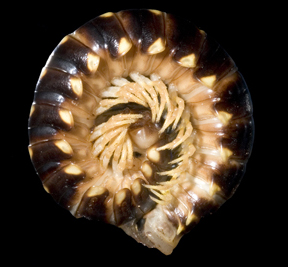
|
Apheloria corrugata
|
|
Photographs and Article by Sarah Moyer |
|
|
Important Facts: 
Common name: Millipede
Habitat: Moist places
like leaf litter, rotting trees,under stones, in caves.
Adult size:
Approximately 5 centimeters
Location: Upstate New York
Lifespan: 1-7 years.
Enemies: Ants, shrews, rodents,
mongoose, frogs, reptiles, birds, other bugs and beetles.
Classification: There are about 8,000-10,000 species of millipedes.
Millipedes are one of the 5 main classes (diplopoda) of arthropods and most
closely related to insects.
What are Millipedes?
Commonly confused with centipedes, millipedes do not bite or
have fangs. Millipedes are best known for their feet. While their name means
“million feet” in Latin, they only have between 80 and 400 feet. They use these
to burrow into the ground to find decaying plants and animals to eat. Millipedes
are a big help to our environment. By eating dead matter, they are recycling
resources. In addition, they help out the worms rotate the soil.
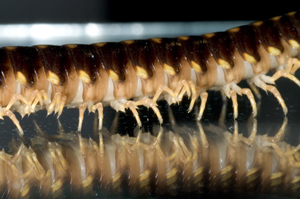
What makes Apheloria corrugate unique?
Apheloria corrugate is a chemistry marvel. It produces hydrogen cyanide (HCN). HCN, also known as cyanide, is a well-known poison that once inhaled will compromise the respiratory processes on a molecular level and in high enough doses result in death.
Storage of the HCN is a slightly complicated task. Since HCN is a gas at room temperature and could harm Apheloria corrugate if they stored it as HCN, their bodies are designed to store it in a special way. On both sides segments 5,7,9,10,12,13, and 15 to 19 of its body, they have two different chambers that each contain a different chemical that produce HCN when they are mixed.
When they want to defend themselves, they release the first chemical (mandelonitrile) from its storage chamber into the reaction chamber that contains an enzyme (benzoyl cyanide). Once these mix, they produce benzoic acid and HCN. It secretes from glandular pores located on each side of 11 segments of its body. They produce droplets that stay attached to the gland opening. Shortly after they secret HCN, the smell of bitter almonds will surface which will kill most of their enemies.
An adult Apheloria corrugate can produce as much as 0.6
milligrams of HCN. This is enough to kill ants and deter many of their other
enemies. It's 6 times the lethal dose of a 25-gram mouse and 0.01 times the
lethal dose of a human.
Photographic Technique:
Equipment used in first set-up:
Camera:
Nikon D-70
Optics: 60mm and 105mm macro lenses
Lighting: Fiber optic
flash
Stage: Copy stand
A piece of glass on top of two lab jacks
Black velvet background
I used this set-up for general pictures of the Apheloria
corrugate . By putting the Apheloria corrugate on the glass that
was raised up by the lab jacks, I was able to make the velvet out of focus in
order to eliminate detail in the fabric. The macro lenses let me get in close.
The fiber optic flash made it easier to photograph while they were moving.
Equipment used in second set-up:
Optics:
Bellows and a 38mm thimble lens
This is the same set up as the first
one, expect for the optics. I wanted to be able to get very close to the
Apheloria corrugate to photograph some of the HCN coming out of a pore.
I was able to get close, but was unable to photograph the HCN coming out of a
pore.
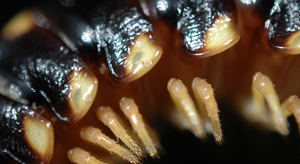
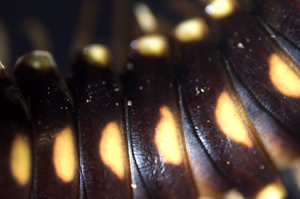
Equipment used in third set-up:
Camera: Nikon D-70
Optics: 105mm macro lens
Lighting: Ring flash
Stage: Copy stand
A piece of glass on top of two lab jacks
White paper background
Black velvet background
The main difference in this set-up is the ring flash. With the
ring flash, I was able to hand hold the camera and photograph naturally with the
lens parallel to the ground. I used this set-up to take photographs of the
Apheloria corrugate from the side. 
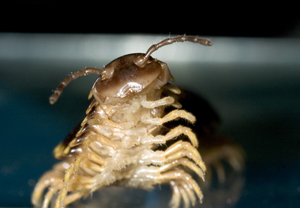
Tips for photographing Apheloria corrugate :
If you put them in the freezer for about 5 minutes, it will slow
their metabolism. When you take them out, they won't move for a little bit, but
will “come alive” in a little. When they do come alive, they will move slower
which will make them easier to photograph.
They like to walk around the
edges of things so have a stage (like a piece of glass) that you can move them
around on easily so that you can see them from the best angle.
To
provoke HCN production, pinch one of their legs a little with forceps. They
should produce HCN in a segment close to the leg that you pinched.
About the Photographer/Author:
Reference:
For the Love of Insects by Thomas Eisner
copyright all images: Sarah Moyer
Return to index of articles
by students on the 'Principles and techniques of photomacrography'
course, November 2004,
Biomedical Photographic Communications (BPC)
program at the Rochester Institute of Technology (RIT).